
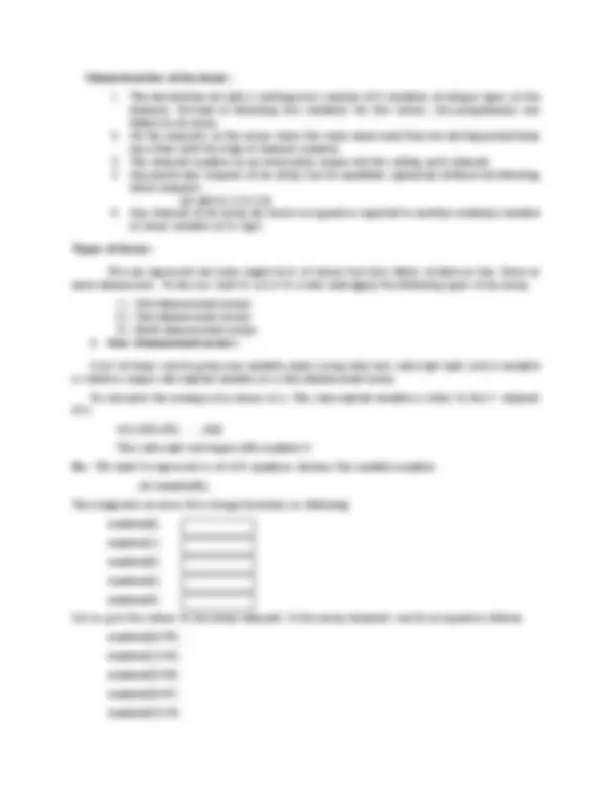
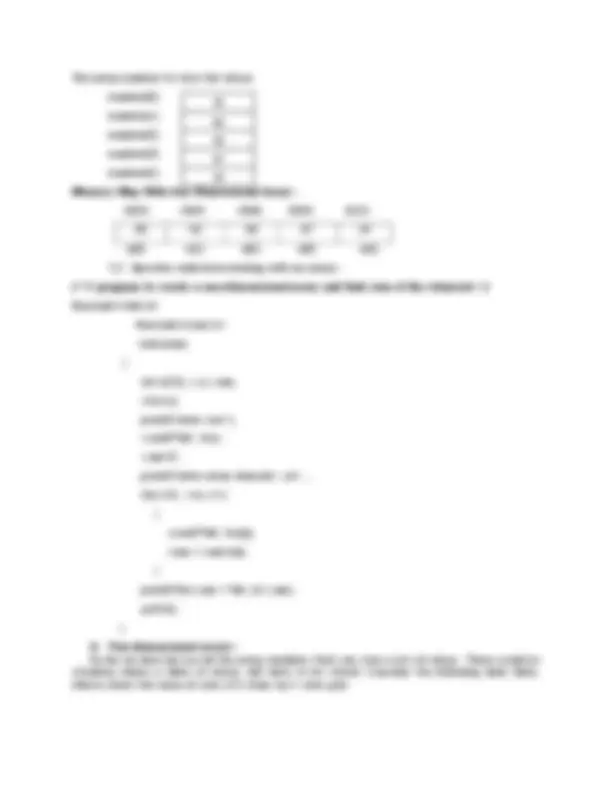
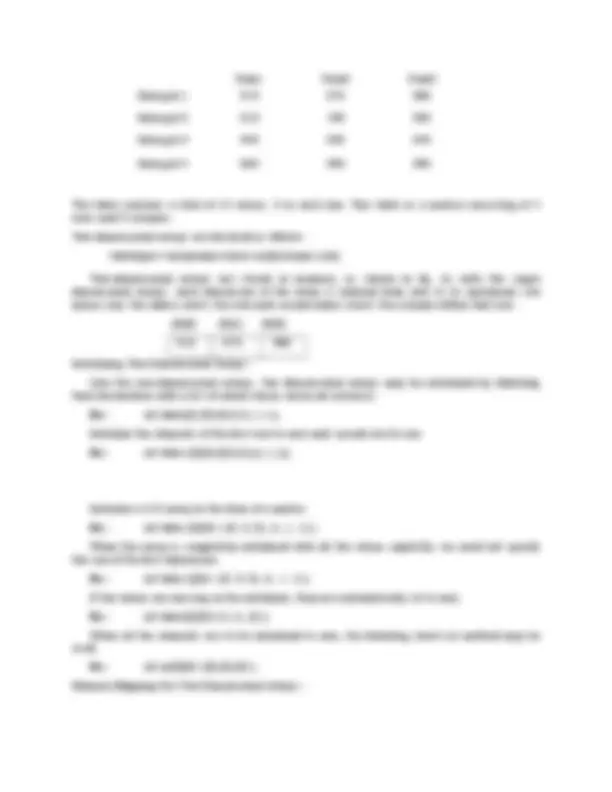
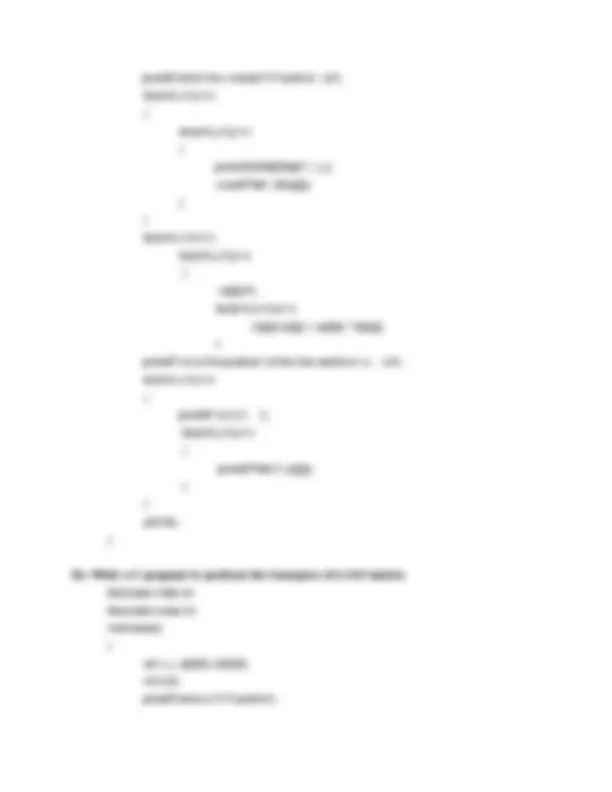
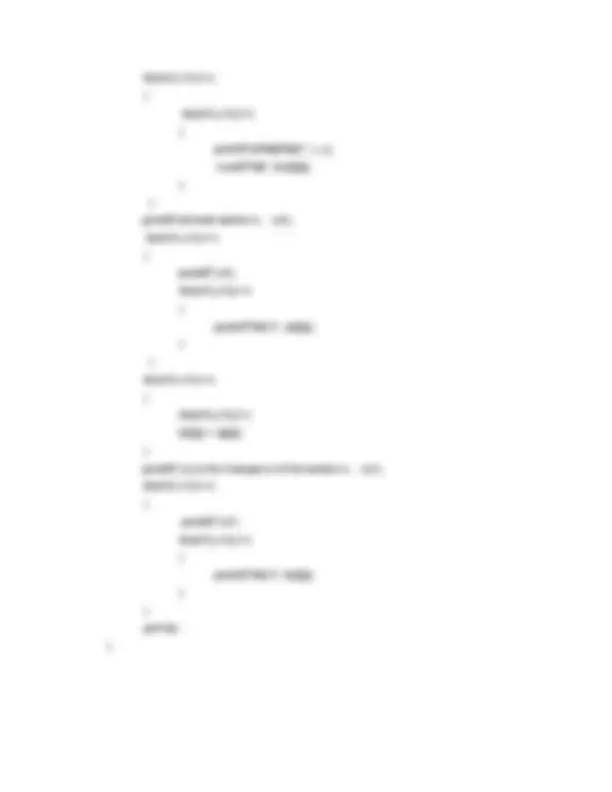
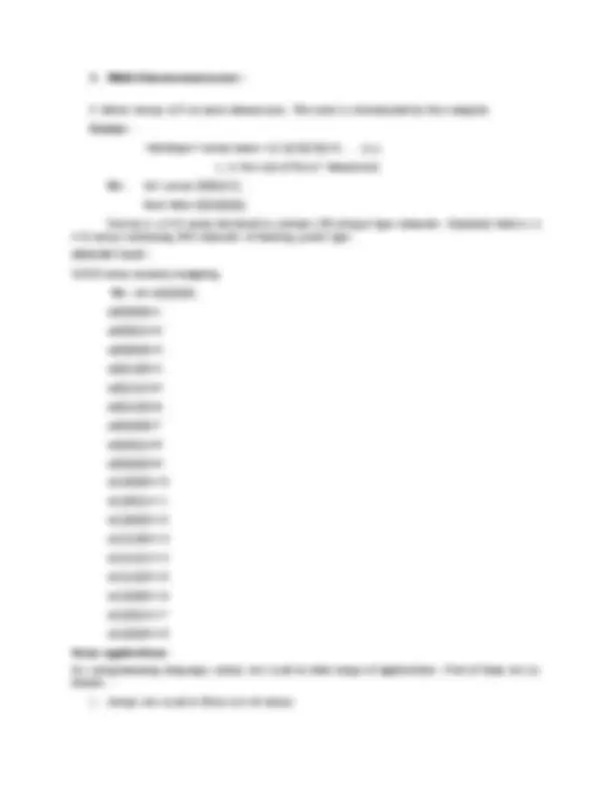
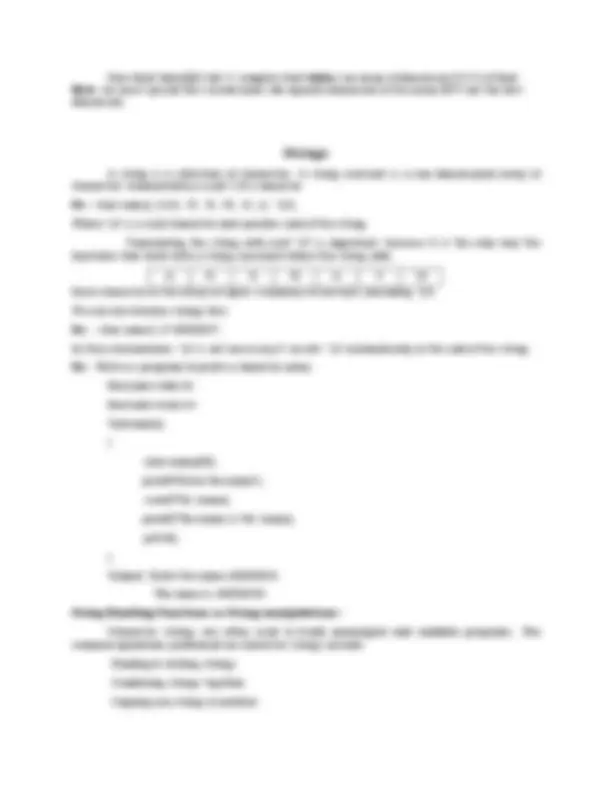
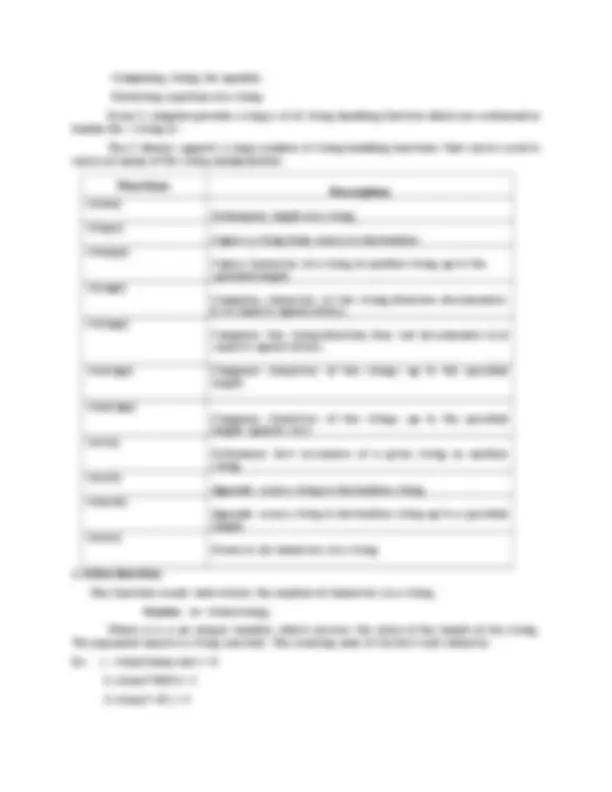
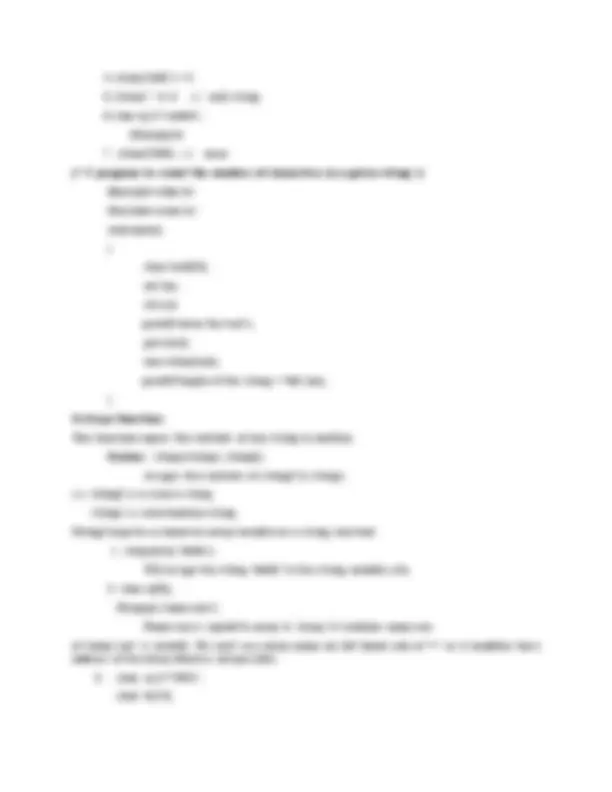
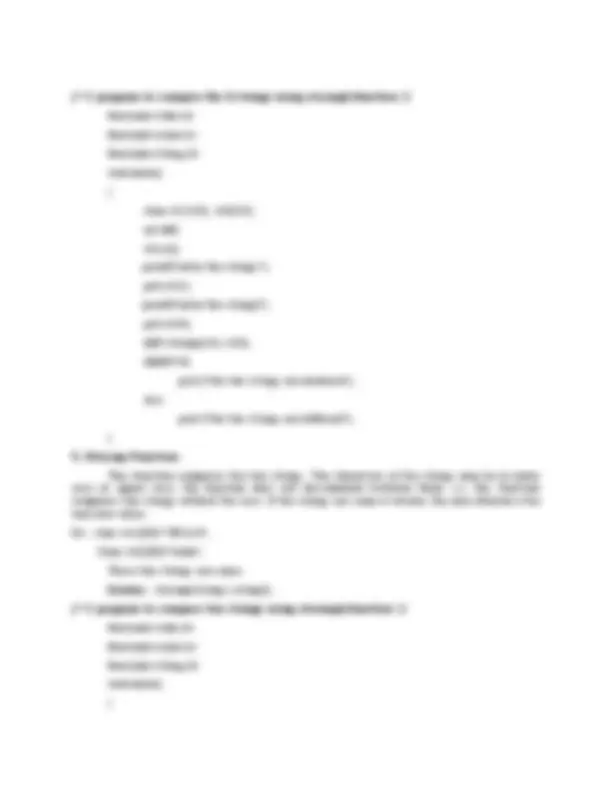
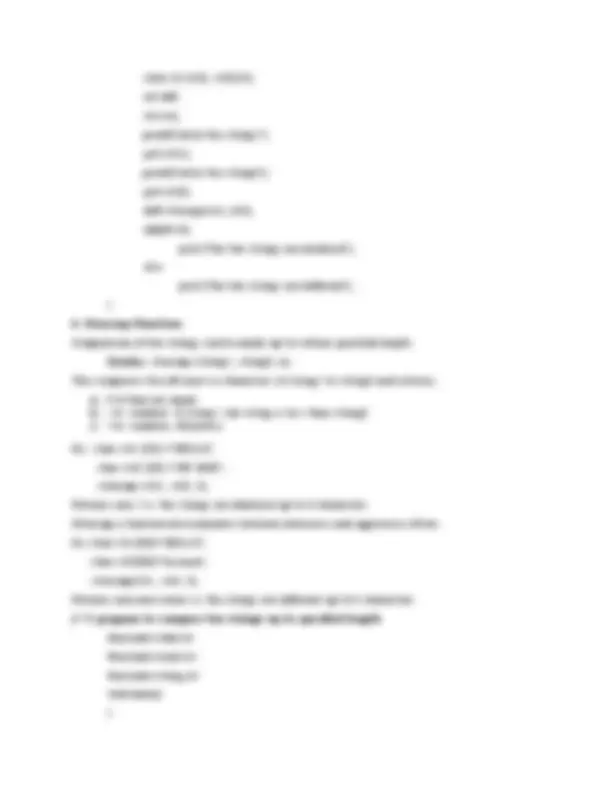
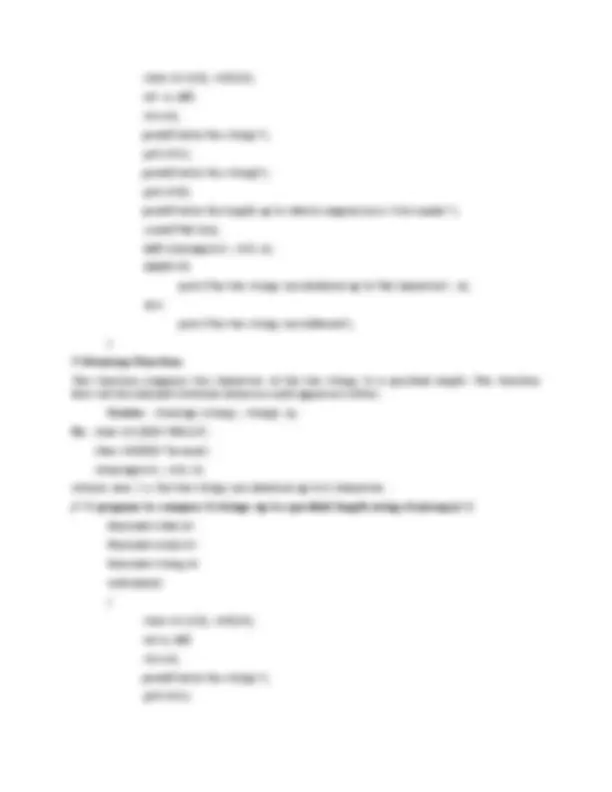
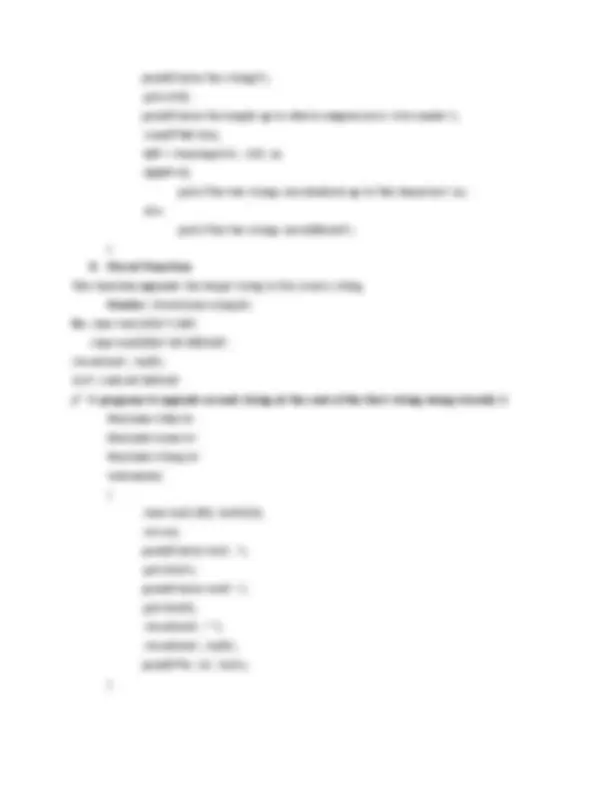
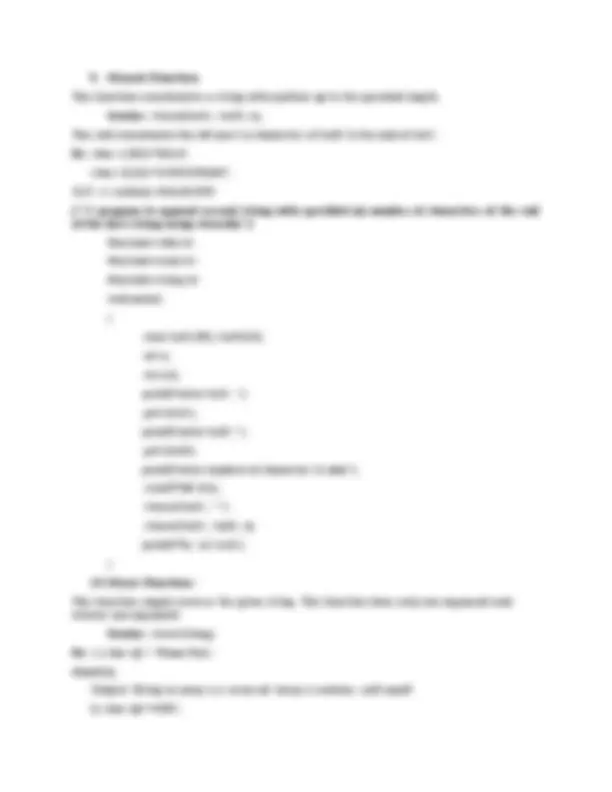
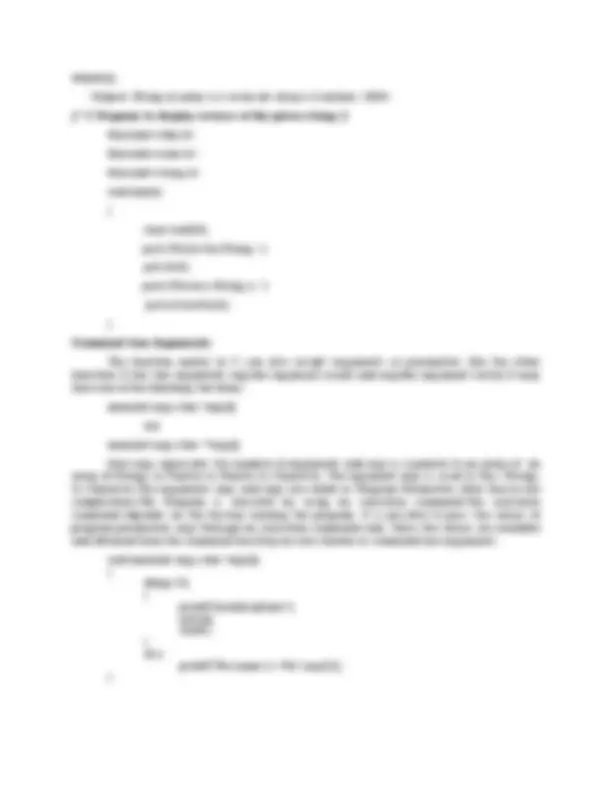


Study with the several resources on Docsity

Earn points by helping other students or get them with a premium plan


Prepare for your exams
Study with the several resources on Docsity

Earn points to download
Earn points by helping other students or get them with a premium plan
Community
Ask the community for help and clear up your study doubts
Discover the best universities in your country according to Docsity users
Free resources
Download our free guides on studying techniques, anxiety management strategies, and thesis advice from Docsity tutors
This document introduces the concept of arrays in C language. It explains the definition, declaration, and initialization of arrays, including one-dimensional and two-dimensional arrays. The document also covers the memory mapping of two-dimensional arrays and provides examples of performing addition, subtraction, and multiplication of matrices using arrays. The drawbacks of initializing a large number of array elements are also discussed.
Typology: Study Guides, Projects, Research
1 / 23

This page cannot be seen from the preview
Don't miss anything!
















Introduction:- #include<stdio.h> #include<conio.h> void main() { int a=2; a=4; printf(“%d”,a); } Output:- 4 a=2 is assigned before assigning 4 to it. When we assign 4 to ‘a’ then the value stored in ‘a’ is replaced with the new value. Hence, ordinary variables can capable of storing one value at a time. This fact is same for all data types. But in application the variables must be assigned to more than one value. This can be obtained with the help of “Arrays”. Definition:- Array is a collection of similar data types in which each element is located in separate memory locations. Array is a Derived data type. Declaration of an Array:- Syntax:-
Here 5 elements are stored in an array ‘a’. The array elements are stored sequentially in separate locations. Array in ‘c’ language indexing starting at ‘0’.Reading of array elements begins from ‘0’. a[0]= a[1]= a[2]= a[3]= a[4]=
The array number to store the values number[0] number[1] number[2] number[3] number[4] Memory Map With One-Dimensional Array:- 4002 4004 4006 4008 4010 35 40 20 57 19 a[0] a[1] a[2] a[3] a[4] “[ ]” Specifies indication dealing with an arrays. / C program to create a ono-dimensional array and find sum of the elements / #include<stdio.h> #include<conio.h> void main { int a[10], i, n, sum; clrscr(); printf(“enter size:”); scanf(“%d”, &n) ; sum=0; printf(“enter array elements \n”) ; for( i=0; i<n; i++) { scanf(“%d”, &a[i]); sum = sum+a[i]; } printf(“the sum = %d \n”,sum); getch(); }
2. Two-dimensional arrays:- So far we have discussed the array variables that can store a list of values. There could be situation where a table of values will have to be stored. Consider the following data table, which shows the value of sales of 3 items by 4 sales girls
Item1 Item2 Item Salesgirl 1 310 275 365 Salesgirl 2 210 190 325 Salesgirl 3 405 235 240 Salesgirl 4 260 300 380
The table contains a total of 12 values, 3 in each line. This table as a matrix consisting of 4 rows and 3 columns. Two-dimensional arrays are declared as follows:
Initializing Two-Dimensional Arrays:- Like the one-dimensional arrays, two dimensional arrays may be initialized by following their declaration with a list of initial values enclosed in braces. Ex :- int table[2] [3]={0,0,0,1,1,1}; Initialize the elements of the first row to zero and second row to one. Ex :- int table [2][3]={{0,0,0},{1,1,1}};
Initialize a 2-D array in the form of a matrix Ex :- int table [2][3]= { {0, 0, 0}, {1, 1, 1} }; When the array is completely initialized with all the values explicitly, we need not specify the size of the first dimension. Ex :- int table [][3]= { {0, 0, 0}, {1, 1, 1} }; If the values are missing in the initializer, they are automatically set to zero. Ex :- int table[2][3]={ {1,1}, {2} }; When all the elements are to be initialized to zero, the following short-cut method may be used. Ex :- int m[3][5]= {{0},{0},{0} }; Memory Mapping For Two Dimensional Arrays:-
for(j=0;j<c1;j++) scanf("%d", &b[i][j]); } printf("\n Matrix Addition \n"); for(i=0;i<r1;i++) { for(j=0;j<c1;j++) printf("%5d", a[i][j] + b[i][j]); printf("\n"); } printf("\n Matrix subtraction \n"); for(i=0;i<r1;i++) { for(j=0;j<c1;j++) printf("%5d", a[i][j] - b[i][j]); printf("\n"); } getch(); } Ex:-Write a C program to perform multiplication of two matrices. #include<stdio.h> #include<conio.h> void main() { int i, j, k, a[3][3], b[3][3], c[3][3]; clrscr(); printf("enter the first 3*3 matrix: \n"); for(i=0;i<3;i++) { for(j=0;j<3;j++) { printf("a[%d][%d]=", i, j); scanf("%d", &a[i][j]); } }
printf("enter the second 3*3 matrix: \n"); for(i=0;i<3;i++) { for(j=0;j<3;j++) { printf("b[%d][%d]=", i, j); scanf("%d", &b[i][j]); } } for(i=0;i<3;i++) for(j=0;j<3;j++) { c[i][j]=0; for(k=0;k<3;k++) c[i][j]=c[i][j] + a[i][k] * b[k][j]; } printf("\n\n the product of the two matrices is : \n"); for(i=0;i<3;i++) { printf("\n\t\t "); for(j=0;j<3;j++) { printf("%d\t",c[i][j]); } } getch(); }
Ex:-Write a C program to perform the transpose of a 3x3 matrix. #include<stdio.h> #include<conio.h> void main() { int i, j, a[3][3], b[3][3]; clrscr(); printf("enter a 3*3 matrix");
3. Multi-Dimensional arrays:-
C allows arrays of 3 or more dimensions. The exact is determined by the compiler. Syntax :-
Passing Arrays to Functions or Functions and Arrays:
One-dimensional Arrays:- Single dimensional arrays can be passed to functions as follows: Ex : #include<stdio.h> #include<conio.h> void main() { int n,i,a[10]; float g; float findavg(int[],int); clrscr(); printf("enter size"); scanf("%d",&n); for(i=0;i<n;i++) scanf("%d",&a[i]); g= findavg(a,n); printf("average is %f",g); getch(); } float findavg(int a[],int n) { float sum=0,avg; int i; for(i=0;i<n;i++) sum=sum+a[i]; return(sum/n); }
Here float table[][5] tells C compiler that table is an array of dimension N X 5 of float. Note : we must specify the second (and subsequent) dimension of the array BUT not the first dimension.
A string is a collection of characters. A string constant is a one dimensional array of characters terminated by a null (‘\0’) character. Ex :- char name[ ]={‘A’, ‘K’, ‘S’, ‘H’, ‘A’, ’y’, ‘\0’}; Where ‘\0’ is a null character and specifies end of the string. Terminating the string with null ‘\0’ is important, because it is the only way the functions that work with a string can know where the string ends. A K S H A Y
Each character in the array occupies a memory of one byte (including ‘\0’) We can also declare strings like Ex :- char name[ ]=”AKSHAY”; In these declarations ‘\0’ is not necessary C inserts ‘\0’ automatically at the end of the string. Ex :- Write a c program to print a character array. #include<stdio.h> #include<conio.h> Void main() { char name[20]; printf(“Enter the name”); scanf(“%s”,name); printf(“The name is %s”,name); getch(); } Output: Enter the name AKSHAYA The name is AKSHAYA String Handling Functions or String manipulations:- Character strings are often used to build meaningful and readable programs. The common operations performed on character strings include: Reading & writing strings Combining strings together Copying one string to another
Comparing strings for equality Extracting a portion of a string Every C compiler provides a large set of string handling function which are contained in header file <string.h> The C library supports a large number of string-handling functions that can be used to carry out many of the string manipulations.
Functions (^) Description strlen() Determines length of a string strcpy() Copies a string from source to destination strncpy() Copies characters of a string to another string up to the specified length strcmp() Compares characters of two strings(function discriminates b/w small & capital letters) stricmp() Compares two strings(function does not discriminate b/w small & capital letters) strncmp() Compares characters of two strings up to the specified length strnicmp() Compares characters of two strings up to the specified length. Ignores case. strstr() Determines first occurance of a given string in another string strcat() Appends source string to destination string strncat() Appends source string to destination string up to a specified length strrev() Reverses all characters of a string
1.strlen function: This function counts and returns the number of characters in a string. Syntax: n= strlen(string); Where n is a an integer variable, which receives the value of the length of the string. The argument may be a string constant. The counting ends at the first null character. Ex: 1. strlen(“rama rao”) = 8 2.strlen(“7893”)= 4 3.strlen(“+-$”) = 3
strcpy(b,a); String in array a is copied to b. Array b contains “7892” char a[ ]=”hyd”, is valid a=”sec”, is invalid. We can use array name on left hand side of = , only in declaration statement but not in executable statement.
/ C program to copy the contents of one string to another string by using strcpy()* #include<stdio.h> #include<conio.h> #include<string.h> void main() { char ori[20], dup[20]; clrscr(); printf(“enter ur name”); gets(ori); strcpy(dup,ori); printf(“original string : %s”,ori); printf(“duplicate string: %s”,dup); } 3.strncpy function: This function copies specified length of characters from source to destination string. Syntax : strncpy(destination,source,n); Where n is the number of left most characters of the source string to be copied. Ex : char s1[20]=”london”; char s2[20]; strncpy(s2,s1,5); This statement copies the first 5 characters of the source string s1 into the target string s2.Therefore s2 contains “London”.
/ C program to copy source string to destination string up to a specified length. Length is to be entered through the key board / #include<stdio.h> #include<conio.h> #include<string.h> void main() { char str1[15], str2[15]; int n; clrscr(); printf(“enter source string”); gets(str1); printf(“enter destination string”); gets(str2); printf(“enter no.of characters to replace in destination string”); scanf(“%d”, &n); strncpy(str2,str1,n); printf(“source string : %s”, str1); printf(“destination string : %s”,str2); } 4.strcmp function: This function compares two strings for finding whether they are same or different. This function discriminates between small and capital letters. Ex: char str1[20]=”HELLO”; char str2[20]=”hello”; these two strings are different. Characters of these strings are compared one by one. In case of a mismatch the function returns non-zero value otherwise zero i.e. when the two strings are same strcmp() returns the value zero. If they are different it returns the numeric difference b/w the ASCII values of non- matching characters. Syntax : strcmp(string1,string2); Ex: strcmp(“their”,”there”);
Will return a value of -9 which is the numeric difference between ASCII “i”(105) and ASCII “r”(114) i.e. “i” minus “r” in ASCII code (105-114 ) is -9. If the value is negative, string1 is alphabetically above string2.
char str1[10], str2[10]; int diff; clrscr(); printf(“enter the string1”); gets(str1); printf(“enter the string2”); gets(str2); diff=stricmp(str1,str2); if(diff==0) puts(“the two strings are identical”); else puts(“the two strings are different”); }
6. Strncmp Function: Comparison of two strings can be made up to certain specified length. Syntax : strncmp (string1, string2, n); This compares the left-most n characters of string1 to string2 and returns, a) 0 if they are equal b) –ve number if string1 sub string is less than string c) +ve number, otherwise
Ex: char str1 [20] =”HELLO”; char str2 [20] =”HE MAN”; strncmp (str1, str2, 2); Returns zero. I.e. the strings are identical up to 2 characters Strncmp () function discriminates between lowercase and uppercase letters. Ex: char str1[20]=”HELLO”; char str2[20]=”he man”; strncmp(str1, str2, 2); Returns non zero value i.e. the strings are different up to 2 characters. / C program to compare two strings up to specified length* #include<stdio.h> #include<conio.h> #include<string.h> void main() {
char str1[10], str2[10]; int n, diff; clrscr(); printf(“enter the string1”); gets(str1); printf(“enter the string2”); gets(str2); printf(“enter the length up to which comparison is to be made:”); scanf(“%d”,&n); diff=strncmp(str1, str2, n); if(diff==0) puts(“the two strings are identical up to %d characters”, n); else puts(“the two strings are different”); } 7.Strnicmp Function: This function compares the characters of the two strings to a specified length. This function does not discriminate between lowercase and uppercase letters. Syntax : strnicmp (string1, string2, n); Ex : char str1[20]=”HELLO”; char str2[20]=”he man”; strnicmp(str1, str2, 2); returns zero. I.e. the two strings are identical up to 2 characters. / C program to compare 2 strings up to specified length using strnicmp () / #include<stdio.h> #include<conio.h> #include<string.h> void main() { char str1[10], str2[10]; int n, diff; clrscr(); printf(“enter the string1”); gets(str1);